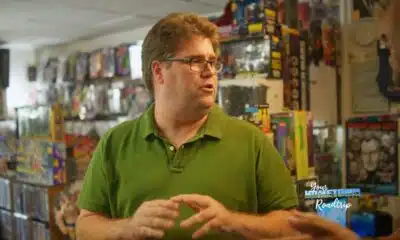News from the South - North Carolina News Feed
Was Helene a 1,000-year storm? Did we have tornadoes in the mountains? • Asheville Watchdog
Today’s round of questions, my smart-aleck replies and the real answers:
Question: There have been various estimates as to the magnitude of the Helene flooding in the French Broad watershed. Some have said it was the 100-year flood. Others have said it was the 500-year flood. The determination is actually fairly straightforward. The calculation can be done for each specific river-gauging station. It is based on the historic record of each year’s highest stage (river level) as recorded at that gauge station. Its accuracy is obviously a function of the length of the record. The longer the record, the greater the statistical soundness of the estimate. The 100-year flood, as you probably know, has nothing to do with 100 years. It is just the flood level that has a 1 percent chance of occurring in any given year. The 500-year flood has a .2 percent chance. The longest gauge record for the Asheville region, based on the U.S. Geological Survey national water data dashboard, appears to be the one on the French Broad River at Asheville. Gauging data are also available on the USGS WaterWatch website. One site says there are discharge data starting in 1985. Another site says the record extends 128 years. Neither site currently appears to be capable of downloading the data set. Can you ask whether anyone has actually determined the nature of the Helene flood at that station? It probably wasn’t the 100-year flood or the 500-year flood, but rather something in-between. A followup question would be how the 2024 flood will cause a reset in the determination of the 100-year flood level for that gauging station.
My answer: I’m going with “one-bazillion-year flood,” mainly because I never want to see another one of these.
Real answer: This is a topic that keeps recurring here, and from what the experts tell me, it certainly seems like a 1,000-year rain event. Whether that translates into a 1,000-year flood event remains a little bit of a gray area.
Nathan Pennington, Buncombe County’s planning director, opened this can of worms at the Nov. 20 daily Helene briefing during a discussion about floodplain management and the National Flood Insurance Program. As Pennington mentioned, the county partners with the state on FEMA flood mapping, with the upshot being the state draws the flood maps for Buncombe.
He showed maps of the Swannanoa area that show the most at-risk section, marked in purple and called the floodway, which are areas that “almost always flood during a rain or storm event.” The next area, in blue, is the 100-year flood area.
“Development is allowed in this area, but standards must be met,” Pennington said, noting that, as the reader said, this means these areas have a 1 percent annual chance of flooding.
Next, in green, was the 500-year flood area, which as Pennington and the reader noted, simply means it has a .2 percent annual chance of flooding.
“What we saw during this event was flood water that so far exceeded the 500-year (flood), it’s very likely we experienced a 1,000-year event, which is not even mapped,” Pennington said.
It’s important to note he said “very likely,” and that he was referring to one area of Swannanoa.
As the reader noted, the U.S. Geological Survey does track river gauge data, so I checked in with public affairs specialist Alexandra Hays to see if it had made a determination, based on the gauge the reader mentioned or any others.
“So, the National Weather Service actually sets the historical designations of ‘100-year-flood, 500-year-flood,’ etc., so to find out how they determine these, you’d have to reach out to them,” Hays said.
More on that in a second.

Like everyone who addresses this topic, Hays also stressed the notion of how “100-year flood” can be misleading. In fact, the USGS has prepared a document on this aptly titled, “The 100-year flood.”
“Hydrologists don’t like to hear a term like ‘100-year flood’ because, scientifically, it is a misinterpretation of terminology that leads to a misconception of what a 100-year flood really is,” the article states, noting that instead hydrologists would say it’s a flood having a 100-year recurrence interval. That’s where the 1 percent chance comes in.
“That being said, we use the term ‘Annual Exceedance Probability’ to track the flooding at individual streamgages, and our teams are still in the process of collecting the needed data to compute the AEPs in areas affected by Helene,” Hays said. “One of our surface water specialists tells me we are going to publish a report of the AEPs for our streamgages in the area for Helene, but it will be a few months before that is available.”
Next, I called up the National Weather Service and spoke to meteorologist Jake Wimberley. Regarding the flood information being given out, Wimberley noted there were “a lot of differing numbers” coming out, because rainfall varies from point to point.
“There were unofficial statements that were really extreme in terms of how rare the event was, so I don’t want to lead you astray,” Wimberley said.
The best source is the National Oceanic and Atmospheric Administration’s data compendium called the Atlas 14 project. That includes analyses that show how much rain would fall at a given point, and how frequently that is expected to recur, which is where the idea of the 100-year event comes from.
Wimberley pulled up data for Asheville Regional Airport, the official recording station for the area.
“So, the airport got 14.19 inches of rain during Helene — the precipitation event that led up to Helene, and the actual passage of the storm,” Wimberley said, noting it was technically listed as a four-day event, although rainfall was very light on that first day.

The 1,000-year measurement for a four-day event would be 11.6 inches.
“So we were over that,” Wimberley said. “And this is for one specific point. I could look at different points and come up with different numbers.”
Indeed, we know rainfall was heavier in certain areas. For instance, Busick in Yancey County recorded 30.78 inches, and Mount Mitchell State Park recorded 24.20 inches, according to a Nov. 7 article on NOAA’s Climate.gov site.
“Estimated rainfall totals from Helene across the southern Appalachians had an Annual Recurrence Interval greater than 1,000 years over a wide area; meaning there is less than a .1 percent chance (annual exceedance probability) of that happening in any given year, according to NOAA’s National Water Center,” the article states.
So that’s indicative of a 1,000-year event.
The North Carolina State Climate office also had an article about Helene that cited the Atlas 14 information, noting that it is “imperfect due to its lack of recent updates.” The office used a three-day measurement of rainfall.
“In Asheville, the three-day total of almost 14 inches goes well beyond the 1-in-1,000 year total for a 72-hour period, which Atlas 14 cites as 11.4 inches,” the article states. “Likewise, the 24.41 inches over three days at Mount Mitchell is off the charts compared to the noted 1-in-1000 year amount of 16.5 inches.”
So, as Wimberley puts it, “The full event in total looks like there were multiple places that it was more than a 1,000-year” rainfall event.
“They haven’t come up with data for more than a one in 1,000-year event,” he added.
Clearly, that much rain translates into a lot of flooding, but it’s tougher to nail down that “1,000-year” designation.
“These major, major rainfall events usually translate to some flooding,” Wimberley said. “But I think it’s more accurate to say this was a 1,000-year rainfall event, as opposed to a 1,000-year flood event.”
Now, as far as Helene causing some kind of “reset” with the data, I contacted David Easterling, director of the National Climate Assessment Technical Support Unit at the National Centers for Environmental Information in Asheville.
“Bottom line is that the National Weather Service is producing a new version of NOAA Atlas 14, which will have both Volume 1 with new values based on the historical observed data, and Volume 2, which will provide estimated values for the future based on climate model projections,” Easterling said.
That means it will include projections related to climate change. Easterling did offer one caveat, though.
“I suspect the Weather Service is far enough along in their data analysis that they may not include Helene, since they expect to release Atlas 15 in 2026,” he said.

Question: We live in Weaverville, in the Reems Creek Golf Community, and we were all incredibly fortunate not to have suffered much in the way of damage to our homes. Our tree-covered streets and homesites, however, lost dozens if not hundreds of trees. While many of them, due to the extensive rainfall before Helene ever hit, were simply toppled from the roots, there were also many that were snapped clean in half at mid-trunk, often with a corkscrew pattern in the wood. This leads us to think that there might have been micro-bursts of mini-tornadoes spawned by the storm. Has there been any official determination to that effect?
My answer: I have micro-bursts of energy these days. It’s the only way I get the Answer Man columns done.\
Real answer: Michael Rehnberg, a National Weather Service meteorologist, said we did not have documented tornadoes in the mountains with Helene. The strongest winds hit around sunrise Sept. 27.
“We had a swath of really strong winds that moved right up the Upstate and then over the state line from South Carolina into North Carolina, and affected a lot of areas in the mountains and the foothills in North Carolina as well,” Rehnberg said. “But those were non-tornadic winds.”

Rehnberg noted that the wind gusts data for Helene has not been certified by the National Centers for Environmental Information, so the numbers are still considered preliminary.
“But all across the Upstate, at least, of South Carolina, and into the southern mountains of North Carolina, there were varying reports of winds over 60 miles an hour,” he said.
That’s clearly strong enough to take down trees, especially with the amount of rain that had fallen over three days, leaving the ground saturated. That can turn root balls into mud, making even large trees vulnerable.
“So when you combine that with higher wind speeds, you can see just kind of the mass devastation — I mean, hundreds, thousands of trees down across these large areas,” Rehnberg said.
The winds were also most devastating on south-facing slopes, as that’s how the storm traveled, from south to north.
A microburst is unlikely to have occurred with this event, Rehnberg said. In a microburst, contracting air aloft descends very suddenly.
“The physics behind that are really closely associated with the way that thunderstorms develop, as opposed to tropical systems,” Rehnberg said. “But that’s not to say that you couldn’t have had very high winds, certainly winds capable of producing the really erratic gusts at the surface.”
Our terrain can play a role with high winds, though, and gusts reaching up into the 60s or maybe higher can cause major, and unusual, tree damage.
“In particular, when you’re dealing with the kind of terrain that you have up in the mountains, what can start out as a simple, straight line wind can simply become very erratic just because it’s responding to all of the rolls and dips in the actual terrain up there,” Rehnberg said.
He would attribute those twisted-looking trees to that phenomenon, he said, not tornadoes.
I’ll note that several sources online, including one academic study, suggest trees will start to break under wind speeds of about 90 mph. But I suspect some other factors could come into play at times, including health of the tree.
Asheville Watchdog is a nonprofit news team producing stories that matter to Asheville and Buncombe County. Got a question? Send it to John Boyle at jboyle@avlwatchdog.org or 828-337-0941. His Answer Man columns appear each Tuesday and Friday. The Watchdog’s reporting is made possible by donations from the community. To show your support for this vital public service go to avlwatchdog.org/support-our-publication/.
Related
The post Was Helene a 1,000-year storm? Did we have tornadoes in the mountains? • Asheville Watchdog appeared first on avlwatchdog.org
News from the South - North Carolina News Feed
What is Chronic Venous Insufficiency? Will Trump be okay?
SUMMARY: President Trump has been diagnosed with chronic venous insufficiency, a common condition in people over 70 causing leg swelling due to blood pooling in veins. The White House confirmed no deep vein thrombosis, arterial disease, or heart issues were found, with normal cardiac function and no signs of systemic illness. Despite visible ankle swelling and bruised hands, attributed to frequent handshaking and aspirin use, the president remains in excellent health and experiences no discomfort. At 79, he stays active, working continuously. The White House emphasized these symptoms are minor and consistent with his busy public engagements and cardiovascular prevention measures.
Swollen legs led to President Donald Trump being diagnosed with what’s called chronic venous insufficiency. It’s a fairly common condition among older adults but requires a thorough checkup to rule out more serious causes of swelling in the legs. Here are some things to know.
Chronic venous insufficiency, or CVI, happens when veins in the legs can’t properly carry blood back to the heart. That can lead to blood pooling in the lower legs. In addition to swelling, usually around the feet and ankles, symptoms can include legs that are achy, heavy feeling or tingly, and varicose veins. Severe cases could trigger leg sores known as ulcers.
WRAL App: https://www.wral.com/download-wral-apps/5787234/
The Latest Weather: https://www.wral.com/weather/page/1010362/
News Tips:
Online – https://www.wral.com/report-it/
Email – assignmentdesk@wral.com
Subscribe to WRAL:
https://youtube.com/c/wral5
Follow WRAL:
Facebook: https://facebook.com/WRALTV
X: https://twitter.com/WRAL
IG: https://instagram.com/wral
About WRAL-TV:
WRAL is your Raleigh, North Carolina news source. Check out our videos for the latest news in Raleigh, local sports, Raleigh weather, and more at https://WRAL.com
#localnews #northcarolina
News from the South - North Carolina News Feed
US House votes to yank funding for NPR, PBS, foreign aid, sending bill to Trump’s desk
SUMMARY: On July 2, 2025, the U.S. House approved legislation to cancel $9 billion in previously authorized spending on public broadcasting and foreign aid, marking only the second time in over 30 years Congress approved a presidential rescissions request. The 216-213 mostly party-line vote sends the bill to President Donald Trump for signature. The Corporation for Public Broadcasting will lose $1.1 billion in funding for NPR, PBS, and local stations. The bill also cuts $8 billion in foreign aid but protects HIV/AIDS, tuberculosis, malaria, and maternal health programs. This follows Senate approval with some adjustments and reflects the White House’s push to focus spending on American interests.
The post US House votes to yank funding for NPR, PBS, foreign aid, sending bill to Trump’s desk appeared first on ncnewsline.com
News from the South - North Carolina News Feed
Missing voter information the objection of NC search
North Carolina State Board of Elections Executive Director Sam Hayes is setting off on a mission to correct 103,000 North Carolinians’ voting records from which some information is missing.
He maintains that the process, dubbed the Registration Repair Project, will not remove any eligible voters from the state’s voter rolls.
According to the state elections board, 103,270 North Carolina registered voters have records that lack either their driver’s license number, the last four digits of their Social Security number or an indication that they have neither.
[Subscribe for FREE to Carolina Public Press’ alerts and weekend roundup newsletters]
Last year, this missing information became the stuff of headlines, lawsuits and the high-profile election protest of Republican Court of Appeals Judge Jefferson Griffin, who lost his bid for state Supreme Court to the incumbent justice, Democrat Allison Riggs, by 734 votes.
In April, the North Carolina Supreme Court declined to remove ballots from the count based on missing identification numbers; they said the state elections board, not voters, was responsible for a faulty voter registration form that didn’t make it abundantly clear that this information was required.
While Griffin lost, the issue he raised remains salient for a newly Republican elections board and the U.S. Department of Justice, which promptly sued the state board over alleged violations of the federal Help America Vote Act’s voter registration provisions.
Thursday, Hayes told reporters that a process he unveiled in late June to gather these missing identification numbers had begun in earnest.
“We must put this issue behind us so we can focus our attention squarely on preparations for accurate and secure municipal elections this fall,” he said.
The plan to collect missing information
There are two groups of voters under Hayes’ plan.
The first group includes registered voters who have never provided a driver’s license, the last four digits of their Social Security number or an affirmation that they lack both. The state elections board has asked county election boards to check their records for these numbers, in case they were provided but not correctly entered into the voting system.
In early August, the state elections board will send letters to the remaining voters in this group requesting the missing information. If affected voters do not comply, they will vote provisionally in future elections. The elections board will create a flag on these voters’ records for poll workers.
The second group includes registered voters whose records do not show that they’ve provided an identification number, but have shown additional documentation at the polls proving their identity and eligibility under HAVA. These voters may vote a regular ballot.
However, the elections board will still send them a letter in a second mailing asking for the missing identification number to bolster the state’s voter records. Even so, if they do not oblige, they still will not be at risk of being disenfranchised, NCSBE General Counsel Paul Cox said.
County election boards have already made progress, and their work will continue as the mailings go out, Hayes said.
Voters can check to see whether they’re on the list of those with missing information by using the Registration Repair Search Tool. If voters don’t want to wait for the August mailing, they can submit an updated voter registration form using their driver’s license through the online DMV portal or visit their county elections board in person with their driver’s license or Social Security card.
“We anticipate the number of voters on the list will decrease quickly as word spreads about this important effort,” Hayes said.
The State Board of Elections unanimously approved the plan last month, despite some concerns from Democrat Jeff Carmon about putting up an extra obstacle for voters because of a problem with missing information that the voters didn’t cause.
“It’s hard to understand starvation if you’ve never felt the pangs of hunger,” Carmon said. “It’s the same situation with voting obstacles. Your perspective of an obstacle may not be the same as someone who’s consistently had their identity and their validity questioned.”
Nonetheless, Carmon and fellow Democrat board member Siobhan Millen ultimately voted in support of the plan.
Same ballot, different rules
Normally, when a voter casts a provisional ballot, the county elections board determines whether their ballot counts by the post-election canvass, held nine days after an election.
Voters may have to provide documentation or information to prove their eligibility to vote in order to be accepted.
The same process applies to the 103,000 affected voters, with a catch. Their vote may be accepted for federal contests, but not state contests, due to a difference in law.

According to the DOJ’s interpretation, the National Voter Registration Act requires all provisional votes of “duly registered voters” to count, Cox said.
But the state elections board has interpreted the state Supreme Court and North Carolina Court of Appeals’ decisions in the Griffin case as requiring a driver’s license, the last four digits of a Social Security number or an affirmation that a voter has neither before accepting their votes in state and local contests.
Under a recent election law change, county election boards have three days to validate and count or reject provisional ballots.
But sometimes, mismatches happen during validation due to database trouble with reading hyphenated names or connecting maiden and married names, for example, Cox said. The board has designed a “fail safe” in case this comes up.
When there’s a mismatch during the validation process, state law allows voters to provide additional documentation — like a driver’s license, bank statement or government document with a voter’s name and address — to prove their eligibility.
“A big chunk of these voters will have already shown HAVA ID, and that’s because in the past, when this information was not supplied, the county boards would still require these voters to show that alternative form of HAVA ID when they voted for the first time,” Cox said.
Poll workers will ask provisional voters to provide this additional documentation so that they can mark it down for later, if validation doesn’t work, he added.
Democrats threaten countersuit
Last week, the Democratic National Committee threatened the state board with litigation if they went ahead with their plan regarding those with missing information.
The letter claimed that the plan would remove eligible voters from the rolls illegally.
Hayes disagrees. In his view, he’s just following the law.
“It’s not the fault of the voters,” he said. “But at the same time, we’re required by the law to go back and collect this information, which should have been done at the time, and it certainly should have been done in the intervening time.”
He also clarified that North Carolina’s photo voter ID requirement won’t suffice for the impacted voters. They still have to vote provisionally so that their identification numbers can go through the validation process, he said.
As for whether his fully fleshed out plan will appease the DNC?
“We hope so,” Hayes said.
This article first appeared on Carolina Public Press and is republished here under a Creative Commons Attribution-NoDerivatives 4.0 International License.
The post Missing voter information the objection of NC search appeared first on carolinapublicpress.org
Note: The following A.I. based commentary is not part of the original article, reproduced above, but is offered in the hopes that it will promote greater media literacy and critical thinking, by making any potential bias more visible to the reader –Staff Editor.
Political Bias Rating: Centrist
This article presents a balanced and factual report on North Carolina’s voter registration issue, focusing on the administrative process and legal context without overt editorializing. It includes perspectives from both Republican and Democratic figures, highlights legal rulings and procedural details, and covers concerns from Democrats alongside the state elections board’s explanations. The language is neutral, aiming to inform about the complexities of voter ID requirements and the Registration Repair Project without endorsing a particular political stance or framing the issue through a partisan lens.
-
News from the South - Tennessee News Feed5 days ago
Bread sold at Walmart, Kroger stores in TN, KY recalled over undeclared tree nut
-
News from the South - Georgia News Feed1 day ago
Aiken County family fleeing to Mexico due to Trump immigration policies
-
News from the South - Arkansas News Feed7 days ago
Man shot and killed in Benton County, near Rogers
-
News from the South - Alabama News Feed6 days ago
Girls Hold Lemonade Stand for St. Jude Hospital | July 12, 2025 | News 19 at 10 p.m. – Weekend
-
News from the South - Georgia News Feed7 days ago
Anti-ICE demonstrators march to Beaufort County Sheriff's Office
-
News from the South - Oklahoma News Feed7 days ago
Police say couple had 50+ animals living in home
-
Mississippi Today4 days ago
Coast judge upholds secrecy in politically charged case. Media appeals ruling.
-
Mississippi Today1 day ago
Driver’s license office moves to downtown Jackson










































